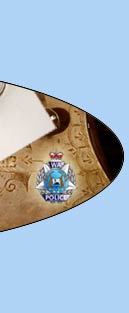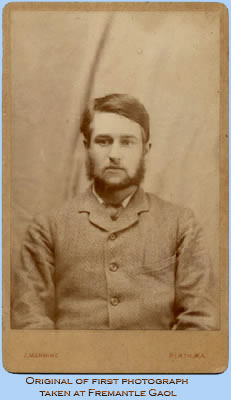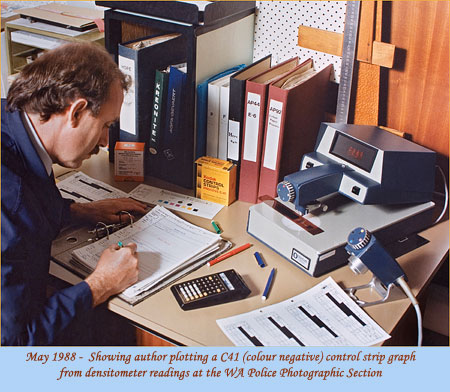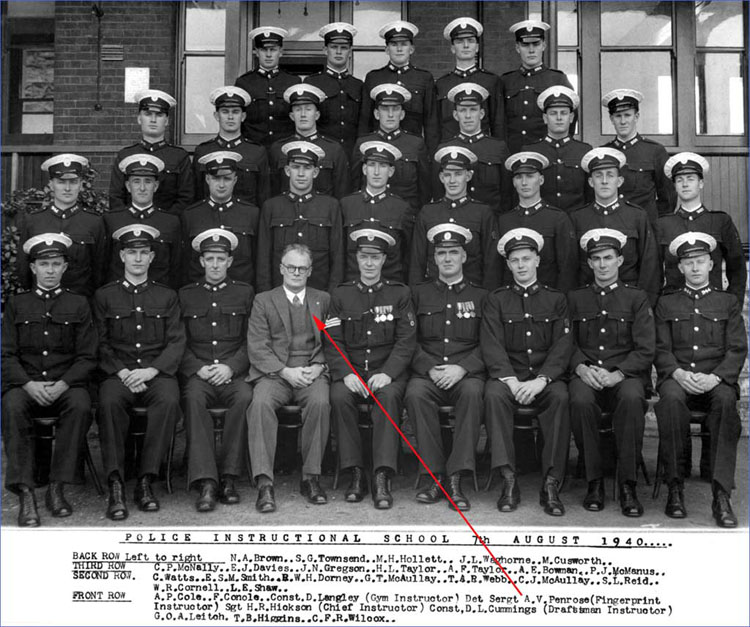 |
 |
 |
||
 |
||||
 |
 |
 |
||
 |
 |
 |
||
 |
||||
 |
 |
 |
||
|
|
|
Two years after the turn of the nineteenth century a policemen was stationed at Fremantle Goal for the sole purpose of photographing all the prisoners there. This remarkable event seeded processes that are today essential tools in so many areas of police investigation. 
The following year a second policeman was stationed at the Gaol to take prisoner fingerprints, an arrangement that continued until 1929. For much of that time a Sergeant Edmunds was the official police photographer. Despite its tremendous potential for other applications, police photography was to be confined within those grim stone walls for more than a quarter of a century. Although not the elite of society, the photographer's 'clients' were given a degree of respectability by the use of a cunning prop known as the 'Fremantle Gaol Old School Tie'. This consisted of a tie glued to a celluloid collar, open at the back, which was placed around the neck of each male prisoner as he was photographed. In 1929, Constable Penrose (later to become O.I.C. of the Fingerprint Bureau), assisted by a Constable Forrest, took over the photographic duties at the Gaol and extended the facilities of this branch of science to the outside world. For the first time the crime, tragedy and history of Western Australia was being captured by police photographers. Many advances have been made since that era, and today police photography is a complex mixture of science, technology, electronics, research and improvisation. Its applications are spreading in as many directions as can be conceived by the imagination. The Police Photographic Section is now situated on the third floor of Police Headquarters in East Perth. It has a staff of eleven policemen (all of whom are photographers and crime scene investigators), three cadets and seven public servants. Most assignments are undertaken in the Metropolitan Area, but work is carried out anywhere in Western Australia, as required. Each of the photographers is issued a crime scene and camera kit, the kits are either equipped with Hasselblads, Mamiya RB 67 or RZ 67 cameras. As well as catering for its own staff, the Section processes work from a variety of other sources, including film from 250 cameras issued to stations and sections around the State. On average 25 colour and 23 black and white films are processed in the Section each day. Cameras on issue to stations and units outside the Section are:
Canon Sure Shot Ricoh 500G Pentax (old style) Optima 335 (Agfa) Agfamatics 200, 208 & 300 Nikonos (Water Police divers) Polaroid 600 Series (12 to various locations) Polaroid 300 SE (T.R.G. & Fremantle) In addition to the routine work, specialised processing is also undertaken, this includes:
Many of the films processed require follow up work such as printing, mounting, captioning, evaluation, comparison, matching, court statements and reports. This work is shared between the police and civilian staff. In the financial year 1986-1987, there were 61,326 assignments taken and/or processed by the Photographic Section staff. The accommodation at Police Headquarters is cramped and services, such as power supply and plumbing, are barely adequate to handle the modern machinery which has evolved in the years since the building was completed. The main processing equipment used in the Section is as follows:

All of these processors have replenishment systems and are monitored each day, by sensitometric methods, to keep them in control. Sworn police staff deal with all the photographic assignments, film processing and colour printing. They also undertake laboratory examinations and comparisons of paint, fibres, glass, clothing, gunshot residues, tool marks, shoe and tyre impressions, light globes from vehicles and anything else which could aid an investigation. Photomicroscopy, using comparison and single stage microscopes, is frequently utilised to assist with these examinations. In the financial year 1986-1987, these eleven sworn officers dealt with 8,268 studio, public relations and crime scene assignments. Each assignment would take between 15 minutes and several days, depending on its complexity. Many of the assignments are in less than ideal conditions, some of the environments are appalling and improvisation is often necessary to get the results required. Whether the job is a murder in the middle of the bush on a winter's night in pouring rain with mud up to the knees, or arson in a blackened multi-storey, crumbling building, the results have to be good enough to present in court. There is no room for error in police photography as there is rarely an opportunity for a re-take. The photographer must keep his equipment and wits in first rate working order so that he, his camera and tube of light can turn out, at a moment's notice, at any time of day or night and deal with any situation, sometimes bordering on the near impossible. 
Return to top |
|
|